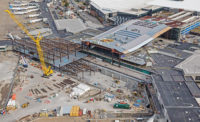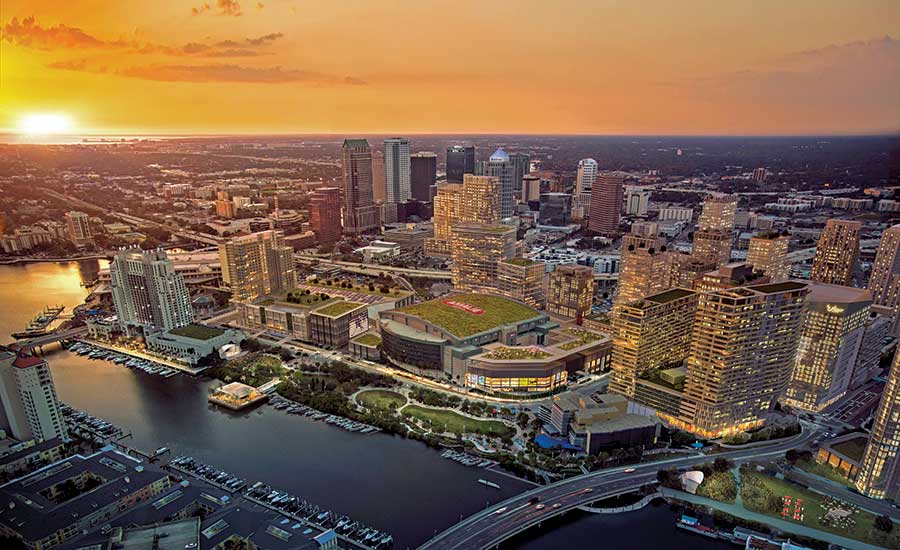Tampa's Waterfront Revamp Builds for the Public Good

Construction on the 19-story, 500,000-sq-ft 400 Channelside office tower— designed by Gensler—is expected to begin this year.
IMAGE COURTESY OF GENSLER

Sparkman Wharf, the former Channelside Bay Plaza, was one of the first components of Water Street Tampa to open to the public.
PHOTO BY NICOLE ABBETT

Sparkman Wharf, the former Channelside Bay Plaza, was one of the first components of Water Street Tampa to open to the public.
PHOTO BY NICOLE ABBETT

The scale of the project in this rendering illustrates what Jeffrey Vinik meant by saying that “half a city” was being built.
IMAGE BY RIVERFILM

Construction on the five-star Tampa Edition hotel and residence tower is targeted to begin this spring.
IMAGE COURTESY OF STRATEGIC PROPERTY PARTNERS





“Transformative” seems too mild an adjective for Water Street Tampa, a $3.5-billion revitalization program currently underway along the city’s waterfront. Certainly, the planned 50-acre community of commercial, residential, hospitality, cultural, entertainment, education and retail development totaling more than 9 million sq ft along the Hillsborough River will be a far cry from the ho-hum assortment of empty industrial buildings and parking lots occupying the area before infrastructure construction began in 2017.
But Water Street Tampa is hardly a routine urban makeover. Along with putting Florida’s third-largest city in step with other high-profile live/work/play-oriented redevelopment efforts around the country, the project aspires to set a new standard for sustainability, health and well-being in the built environment that will likely be emulated worldwide.
“Even if there is a dip, we’re looking for long-term value.”
– James Nozar, CEO, Strategic Property Partners
The pursuit of such an ambitious vision is familiar territory for the backers of Water Street Tampa’s development firm, Strategic Property Partners LLC (SPP). Formed in 2014, the 56-person company is a joint venture between the Bill Gates-owned Cascade Investment LLC private capital fund and Jeffrey Vinik, a former hedge fund manager who now owns the National Hockey League’s Tampa Bay Lightning and holds a minority interest in baseball’s Boston Red Sox.
SPP is in the midst of the 4-million-sq-ft first phase that is as diverse as it is aggressive. The company enjoyed multiple milestones in 2018, putting its Water Street Tampa project on track to live up to Vinik’s once-stated goal of building “half a city,” and earned SPP Owner of the Year honors from ENR Southeast.
The developments of 2018 include the construction start of the Tampa JW Marriott hotel. Designed by Nichols Brosch Wurst Wolfe & Associates and Champalimaud Design, the 519-room hotel is slated to open in the fall of 2020—in time to serve as the host hotel for Super Bowl LV, which will be played in Tampa the following February.
Also getting underway last year was 815 Water Street, a 26- and 21-story dual-tower residential building designed by Kohn Pedersen Fox Associates and Cecconi Simone that will feature a distinctive exterior of serrated terraces for its 420 rental units.
Renovations were also part of Water Street 2018 activity. Projects included the 727-room Marriott Waterside Hotel and Marina, and Sparkman Wharf, which converts the former Channelside Bay Plaza retail center into 245,000 sq ft of renovated waterfront office and retail space. An adjacent park, bandshell and outdoor dining areas—the first components of Water Street Tampa’s planned 13 acres of parks and enhanced public spaces—opened to the public late in the year.
Community Partner
Its financial muscle may justify SPP’s claim that Water Street Tampa is “one of the most secure and well-capitalized real estate development projects in the country,” but collaboration has been the company’s watchword from the outset.
Craig Richard, president and CEO of the Tampa Hillsborough Economic Development Corp., says SPP communicates constantly with local officials and neighboring areas, and never passes up an opportunity to deliver presentations at community meetings.
“They are the ideal community partner,” Richard says.
SPP’s CEO James Nozar responds that the benefits of such outreach work both ways.
“We’ve encountered day-to-day bumps and issues like any other large-scale development,” says Nozar, who joined SPP in early 2016 after a 10-year stint overseeing multiple Washington, D.C.-area mixed-use developments for JBG Cos. “Thanks to the involvement and creativity of our stakeholders, we’ve been able to get through them.”
That includes SPP’s primary construction partner, Miami-based Coastal Construction Group, which has assumed the role as general contractor for Water Street Tampa’s first phase after SPP had worked with multiple large contractors during the project’s pre-construction phase.
Nozar explains that the company’s “pivot” to a single GC enabled it to capitalize on Coastal’s ability to supply the labor and other resources necessary to meet an aggressive construction schedule.
“Their experience and connections in this region are important to us as a new development company,” Nozar says. “They’ve been a fantastic partner.”
Dan Whiteman, vice chairman of Coastal Construction, notes that having a single GC for the first phase has facilitated better coordination across Water Street Tampa’s concurrent projects.
“Because we’re releasing projects block by block, the subs are better able to pace their pricing,” Whiteman says. “The subs have responded extremely well, and we’re getting good prices.”
Nozar expects SPP’s deep capital pockets to sustain construction on Water Street Tampa through its planned 10-year build-out, despite looming uncertainties about the potential for an economic downturn, which in even mild cases can short-circuit urban revitalization efforts.
“Even if there is a dip, we’re looking for long-term value,” he says.
David Bevirt, SPP’s executive vice president of corporate leasing, notes other advantages that reinforce Water Street Tampa’s staying power, from the city’s “unbeatable climate” to a recently enacted 1-cent sales tax increase that will provide $300 million a year for road and traffic improvements.
“It’s an already attractive market that’s doing smart things to addressing the needs of consumers and the business community,” Bevirt says.
Richard believes SPP’s comprehensive, big-picture thinking also sets Water Street Tampa apart from other urban revitalization projects.
“Often times, downtown plans will occur from a stakeholder perspective on what they would like to see and it’s hard to have the resources to get those things done,” he explains. “Water Street Tampa is backed by strong financial partners, best-in-class urban planners and it’s a market-based development. All of those things spell success for a first-class development.”
SPP complemented its substantial impact on Tampa’s construction economy in 2018 with more than $375,000 of charitable giving. Among the more than 30 beneficiary organizations are Walk Bike Tampa, the American Heart Association and Tampa Bay Businesses for Culture and the Arts.
Ahead: Much More
This coming year plans to be equally busy for Water Street Tampa, with the planned spring groundbreaking for its third major hospitality component, the five-star Tampa Edition hotel and residences, which will include 173 hotel rooms and 35 residences.
Also set to break ground are Tampa’s first major office towers in nearly three decades—1001 Water Street, a 385,000-sq-ft, 20-story residential and retail building to be designed by biophilic design specialist Cookfox, and 400 Channelside, a 19-story, 500,000-sq-ft tower designed by Gensler.
SPP has also laid the groundwork for its long-term construction agenda with the October 2018 purchase of the former ConAgra flour mill site, located just north of Water Street Tampa’s core for a reported $13 million. Bevirt calls the three-acre site essential to sync the street grid of Water Street Tampa’s second phase with the central business district. SPP also plans to create a new east-west route through the downtown core, enhancing access to Water Street Tampa and other waterside areas.
SPP also plans to take Water Street Tampa quality-of-life attributes to a new level, making it the first community-level project to be certified under the WELL Building Institute’s seven-category building standard, which focuses on building performance, including air, water, nourishment, light, fitness, comfort and mind.
Complementing LEED, which focuses on design and construction aspects, “WELL requires us to maintain that certification by ensuring buildings operate at a high standard,” Bevirt says. “These kinds of environments build on data that link healthy buildings to healthier people, which means fewer sick days, more productivity and a better quality of life.”
Working with New York City-based wellness real estate planner Delos, SPP will pursue WELL Certification for Water Street Tampa buildings as well as for parks and public spaces—what Nozar calls “the glue that connects those built elements.” They include sidewalks up to 45 ft wide, hundreds of low-pollen trees and integrated sound barriers to support acoustic comfort as well as internet infrastructure to support autonomous and connected vehicles.
Though scale and livability may distinguish Water Street Tampa from other efforts, Nozar says the development may truly distinguish itself as a new model for a city that evolved out of a car-centric culture.
“This is something new for Tampa and for Florida,” Nozar says. “The scale of what we’re doing is big, and so too are the expectations. It’s up to us to create something very special.”








